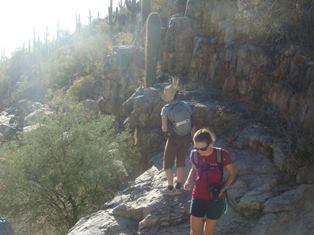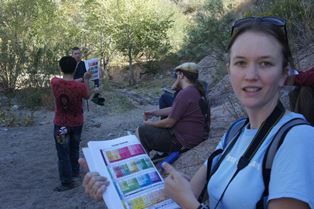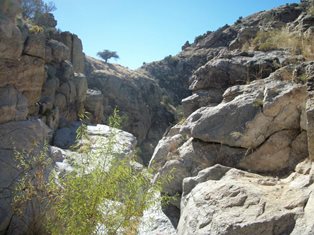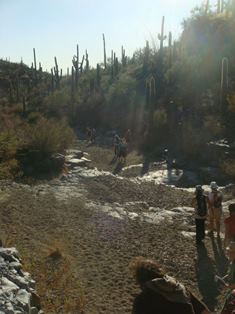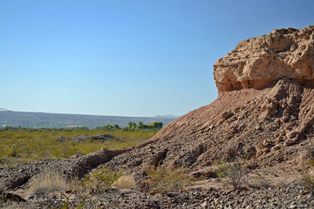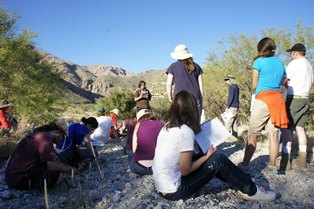LPL Fieldtrip Fall 2012 – Circum-Tucson
Despite our tendency to crisscross the whole southwestern U.S. on these trips, there is an incredibly interesting geologic story sitting on our doorstep here in the Tucson area. There has been growing interest among the fieldtrip group in understanding more about the processes that have fashioned the local landscape around Tucson and that was finally satisfied this semester.
From a geological point of view, we’re fortunate here in the Southwest to be so close to the edge of North America. Our geologic story is largely shaped by our proximity to this active plate boundary over the past hundred million years or so. Prior to that, southern Arizona had a mix of dry periods and marine incursions. One of these marine periods led to the formation of limestone rocks, which would likely have remained obscure were it not for the fabulous caves that formed within them. We had the chance to visit one of these caves at Kartchner Caverns, discovered less than 40 years ago by Gary Tenen and Randy Tufts (an LPL alum). Other sedimentary rocks that predate the main volcanic and tectonic stories recorded at Tucson can be seen east of the Tucson Mountains too. However, most of the geologic story we followed started in the late Cretaceous – just before the disappearance of the dinosaurs.
About seventy million years ago there was an oceanic plate (called the Farallon plate), to our west, that was in the process of disappearing beneath North America. As younger and younger portions of this oceanic plate were dragged beneath our continent they began to float higher and eventually grate along the underside of North America compressing our continent and building mountains. A wave of volcanic activity passed eastward through the Tucson area ahead of this and large ash-flow calderas dotted the landscape. We visited the remnants of one of these in the Tucson Mountains. Here, large quantities of volcanic ash are welded together forming the rocks we see (and can be comfortably examined at Gate’s Pass). During this period, hydrothermal circulation around the subterranean magma chambers led to the concentration of much of Arizona’s copper and other minerals that we continue to mine today.
Probably the most shocking part of this part of the story is that the Tucson Mountains are no longer sitting above the magma chamber that fed them. That magma chamber is likely part of the Catalina and Rincon mountains on the other side of town! How then did the surface volcanoes end up so far away from where they started? As the trailing edge of the Farallon plate disappeared beneath North America its angle of descent steepened and it stopped compressing the continent. The mountain ranges produced earlier began to collapse and the crust to spread outward. This crustal spreading manifested itself on the surface in the Tucson area as nearly horizontal faults. Thus the Tucson mountains were able to slide, nearly horizontally, westward off the top of their (now solidified) magma chamber. Without the weight of the Tucson Mountains above it, the buried granite could rise up buoyantly above the surface. The Rincon and Catalina Mountains are these magma chambers. We visited the fault where the surface rocks slid off the buried magma chambers to the south and east of these mountains. Having the surface volcanoes scrapped off like this has consequences for the granite of the magma chamber too. The heat and pressure generated in the region being sheared metamorphoses the granite into mylonite – a rock with a texture that can tell you details of the direction of the shear. We saw plenty of examples of mylonite on the Catalina Highway – this metamorphism progressed to different extents in different places and is barely apparent at all behind the steep Catalina forerange. These uplifted partly-metamorphosed magma chambers, where the original surface rocks have been moved off, are called metamorphic core complexes. They are known to be widespread now, but were first recognized in this classic Tucson example.
Stretching of the crustal rocks continued in a different form as the Farallon plate peeled away from the underside of North America and volcanic activity returned producing dikes that are visible today in the Tucson Mountains. Steeper faults now formed and occurred in sets that allowed intervening valley floors to drop downward nearly intact. The alternating basins and mountain ranges this produced can be seen throughout the southwest. Tucson itself sits in one of these basins and we visited a classic example of one of these basin-and-range faults near Oracle named the Pirate Fault.
With the basin floors dropping, the surrounding mountains shed material that began to fill in these low areas. This continues to this day and we saw examples of bedrock channels and debris flows that have contributed material to the basin fill. As the mountains erode backward and shed more debris both alluvial fans and pediment surfaces can form. Compaction of sediment above buried pediments can also lead to fissures opening up on the surface – a process that we saw has accelerated around Wilcox in recent times as groundwater is mined for agriculture.
Within the infilling basins, lakes alternated with playas as climatic conditions shifted. Eventually the basins became so full of sediment that they began to overflow allowing drainage waters to move from basin to basin. After the basins were integrated in this way lakes gave way to thoroughgoing rivers. The San Pedro river sediments tell this complete story very well and there are great exposures of them in the Saint David’s Formation near Benson.
Despite all the buildings, agriculture and people around Tucson there’s still a lot of geology to see. This trip has certainly provided us with an appreciation of the local story and how it fits into the broader forces at work as Earth’s tectonic plates (and perhaps those of some extrasolar planes) jostle past each other over geologic time.
|
|
|
|
|
|
|
|
|


